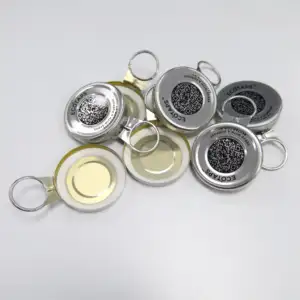
Tianlei Factory Wholesale Customized Synthetic Cork Stopper Liquor Stopper Rubber Wine Stopper Hollow Plug Custom LOGO

Factory Sale Ring Pull Bottle Caps Easy Open Lids Spill Proof Aluminium Closure For Bottle Wine Beer Beverage

















In the world of winemaking, the humble wine cork transcends its role as a mere bottle stopper; it becomes a symbol of tradition, craftsmanship, and the artistry of preserving liquid gold.
A wine cork is a cylindrical stopper used to seal a wine bottle. Typically made from the bark of the cork oak tree (Quercus suber), these stoppers have been the traditional choice for sealing wine bottles for centuries. The elasticity and impermeability of cork make it an ideal material for preserving the quality of wine by preventing air from entering the bottle. Extracting cork from the tree involves harvesting the outer bark, which naturally regenerates, making cork a sustainable and eco-friendly choice. Despite the availability of alternative closures like screw caps or synthetic corks, many winemakers and enthusiasts value the tradition and performance of natural cork for sealing fine wines.
Wine corks, crafted from the bark of cork oak trees, boast features that make them a favored choice for sealing wine bottles. Their remarkable elasticity allows them to fit snugly into bottlenecks, forming a tight seal that prevents air infiltration and wine leakage. This natural impermeability safeguards the quality of wine by shielding it from detrimental interactions with the surrounding air. Beyond functionality, the sustainability of cork production is noteworthy, as harvesting involves collecting the bark without harming the tree, promoting eco-friendly practices. Cork's biodegradability aligns with environmental concerns, and its association with tradition and quality adds a touch of prestige to wine packaging. Additionally, the controlled oxidation facilitated by wine cork can benefit wines meant for aging, contributing to their flavor development. With an aesthetic appeal that enhances the overall presentation of wine bottles, cork stoppers remain a symbol of craftsmanship and tradition. At the same time, alternative closures offer advantages in the dynamic winemaking landscape.
Wine corks come in various types, each tailored to specific characteristics and uses. Natural wine corks, crafted from cork oak bark, are the traditional choice, known for elasticity and impermeability. Agglomerated wine corks, made from cork granules and adhesive, offer an economical alternative suitable for shorter-term storage. Twin disc wine corks, with two flat cork discs, provide a cost-effective option for efficient bottle sealing. Champagne wine corks, designed for sparkling wines, are larger and thicker to withstand pressure. Synthetic wine corks, made from materials like plastic, cater to wines meant for early consumption. Colmated wine corks undergo a process to enhance appearance and maintain natural cork characteristics. Technical wine corks, a composite of natural cork particles, minimize the risk of cork taint. Sparkling wine corks, similar to Champagne corks, have a reinforced structure. Innovations include: Cork discs and Zorks. Combining cork with alternative closures and screw caps. Offering a secure seal for wines intended for immediate enjoyment. Winemakers select the appropriate cork type based on factors such as wine style, aging requirements, and cost considerations, ensuring a diverse range to meet the industry's evolving needs.
Explore the sustainable nature of cork harvesting, emphasizing its positive impact on the environment and the global industry. Learn how wine cork oak trees contribute to biodiversity and the responsible practices that make cork an eco-friendly choice in an era where sustainability is paramount.